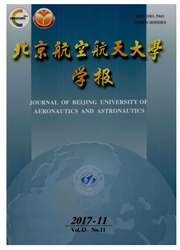

 中文摘要:
中文摘要:
作为新型航天器姿态机动执行机构,磁悬浮控制力矩陀螺(MSCMG)长时间工作在高真空环境下且高速转子完全悬浮,散热条件差,系统温度过高,导致陀螺组件产生较大的热应力,降低了陀螺结构部件的强度。为减小温度场对陀螺结构部件强度的影响,提高陀螺结构的可靠性,采用有限元法计算出磁悬浮控制力矩陀螺工作状态下的温度场,并基于温度场分析陀螺结构部件的应力分布情况,明确温度场对陀螺结构部件力学性能产生的影响。建立了陀螺热网络模型,根据热网络模型与热网络方程分析热量传递路径及温度影响因素,并提出相应的优化措施。经优化,定子组件最高温度从66.5℃降至49℃,转子组件最高温度从91.7℃降至76.9℃。陀螺定子组件的强度安全系数由1.52提升为1.73,提高了13.8%,陀螺转子组件的强度安全系数由1.32提升为1.56,提高了18.2%。
 英文摘要:
英文摘要:
As a novel actuator for spacecraft attitude maneuver,magnetically suspended control moment gyroscope( MSCMG) operates in a high vacuum with high speed rotor suspended,leading to poor dissipating heat conditions and high system temperature,which result in the larger thermal stress and weaken the structure strength of MSCMG. To reduce the influence of temperature field on the strength of MSCMG components and improve the reliability of MSCMG structure,finite element method is applied to calculate the temperature field of MSCMG under the working state and analyze the stress distribution in MSCMG components based on the temperature field to understand the influence of temperature field on the mechanical properties of MSCMG components. Moreover,the thermal network model of MSCMG is established. The heat flux path and the factors influencing temperature are analyzed according to the thermal network model and the thermal network equations. And then,the optimization measurements are put forward. After optimization,the maximum temperature of stator assembly decreases from 66. 5℃ to 49℃ and that of rotor assembly decreases from 91. 7℃ to76. 9℃. In addition,the safety factor of stator assembly increases from 1. 52 to 1. 73( increases by 13. 8%)and that of rotor assembly increases from 1. 32 to 1. 56( increases by 18. 2%).
 同期刊论文项目
同期刊论文项目
 同项目期刊论文
同项目期刊论文
 期刊信息
期刊信息
